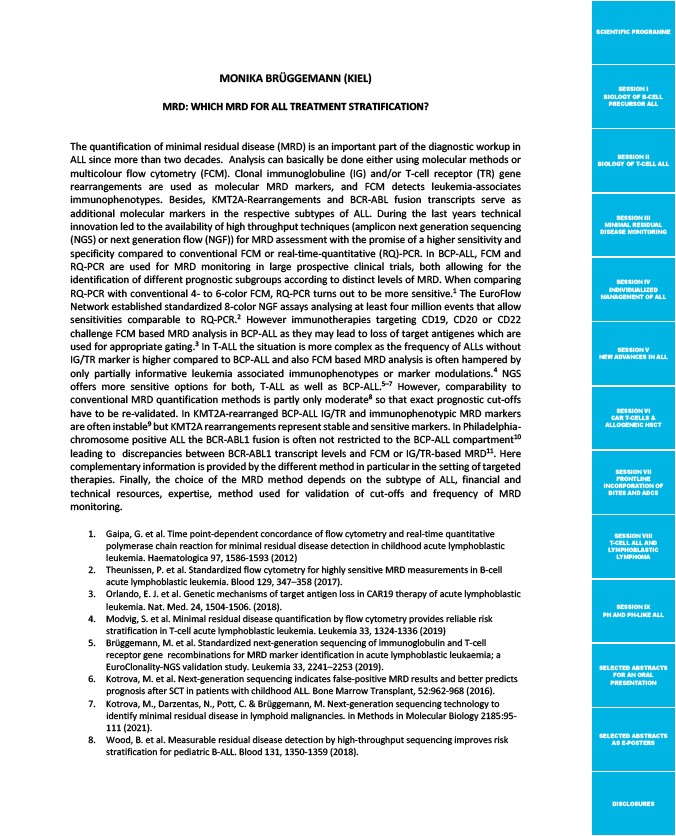
SCIENTIFIC PROGRAMME
SESSION I
BIOLOGY OF B-CELL
PRECURSOR ALL
SESSION II
BIOLOGY OF T-CELL ALL
SESSION III
MINIMAL RESIDUAL
DISEASE MONITORING
SESSION IV
INDIVIDUALIZED
MANAGEMENT OF ALL
SESSION V
NEW ADVANCES IN ALL
SESSION VI
CAR T-CELLS &
ALLOGENEIC HSCT
SESSION VII
FRONTLINE
INCORPORATION OF
BITES AND ADCS
SESSION VIII
T-CELL ALL AND
LYMPHOBLASTIC
LYMPHOMA
SESSION IX
PH AND PH-LIKE ALL
SELECTED ABSTRACTS
FOR AN ORAL
PRESENTATION
SELECTED ABSTRACTS
AS E-POSTERS
DISCLOSURES
MONIKA BRÜGGEMANN (KIEL)
MRD: WHICH MRD FOR ALL TREATMENT STRATIFICATION?
The quantification of minimal residual disease (MRD) is an important part of the diagnostic workup in
ALL since more than two decades. Analysis can basically be done either using molecular methods or
multicolour flow cytometry (FCM). Clonal immunoglobuline (IG) and/or T-cell receptor (TR) gene
rearrangements are used as molecular MRD markers, and FCM detects leukemia-associates
immunophenotypes. Besides, KMT2A-Rearrangements and BCR-ABL fusion transcripts serve as
additional molecular markers in the respective subtypes of ALL. During the last years technical
innovation led to the availability of high throughput techniques (amplicon next generation sequencing
(NGS) or next generation flow (NGF)) for MRD assessment with the promise of a higher sensitivity and
specificity compared to conventional FCM or real-time-quantitative (RQ)-PCR. In BCP-ALL, FCM and
RQ-PCR are used for MRD monitoring in large prospective clinical trials, both allowing for the
identification of different prognostic subgroups according to distinct levels of MRD. When comparing
RQ-PCR with conventional 4- to 6-color FCM, RQ-PCR turns out to be more sensitive.1 The EuroFlow
Network established standardized 8-color NGF assays analysing at least four million events that allow
sensitivities comparable to RQ-PCR.2 However immunotherapies targeting CD19, CD20 or CD22
challenge FCM based MRD analysis in BCP-ALL as they may lead to loss of target antigenes which are
used for appropriate gating.3 In T-ALL the situation is more complex as the frequency of ALLs without
IG/TR marker is higher compared to BCP-ALL and also FCM based MRD analysis is often hampered by
only partially informative leukemia associated immunophenotypes or marker modulations.4 NGS
offers more sensitive options for both, T-ALL as well as BCP-ALL.5–7 However, comparability to
conventional MRD quantification methods is partly only moderate8 so that exact prognostic cut-offs
have to be re-validated. In KMT2A-rearranged BCP-ALL IG/TR and immunophenotypic MRD markers
are often instable9 but KMT2A rearrangements represent stable and sensitive markers. In Philadelphia-chromosome
positive ALL the BCR-ABL1 fusion is often not restricted to the BCP-ALL compartment10
leading to discrepancies between BCR-ABL1 transcript levels and FCM or IG/TR-based MRD11. Here
complementary information is provided by the different method in particular in the setting of targeted
therapies. Finally, the choice of the MRD method depends on the subtype of ALL, financial and
technical resources, expertise, method used for validation of cut-offs and frequency of MRD
monitoring.
1. Gaipa, G. et al. Time point-dependent concordance of flow cytometry and real-time quantitative
polymerase chain reaction for minimal residual disease detection in childhood acute lymphoblastic
leukemia. Haematologica 97, 1586-1593 (2012)
2. Theunissen, P. et al. Standardized flow cytometry for highly sensitive MRD measurements in B-cell
acute lymphoblastic leukemia. Blood 129, 347–358 (2017).
3. Orlando, E. J. et al. Genetic mechanisms of target antigen loss in CAR19 therapy of acute lymphoblastic
leukemia. Nat. Med. 24, 1504-1506. (2018).
4. Modvig, S. et al. Minimal residual disease quantification by flow cytometry provides reliable risk
stratification in T-cell acute lymphoblastic leukemia. Leukemia 33, 1324-1336 (2019)
5. Brüggemann, M. et al. Standardized next-generation sequencing of immunoglobulin and T-cell
receptor gene recombinations for MRD marker identification in acute lymphoblastic leukaemia; a
EuroClonality-NGS validation study. Leukemia 33, 2241–2253 (2019).
6. Kotrova, M. et al. Next-generation sequencing indicates false-positive MRD results and better predicts
prognosis after SCT in patients with childhood ALL. Bone Marrow Transplant, 52:962-968 (2016).
7. Kotrova, M., Darzentas, N., Pott, C. & Brüggemann, M. Next-generation sequencing technology to
identify minimal residual disease in lymphoid malignancies. in Methods in Molecular Biology 2185:95-
111 (2021).
8. Wood, B. et al. Measurable residual disease detection by high-throughput sequencing improves risk
stratification for pediatric B-ALL. Blood 131, 1350-1359 (2018).